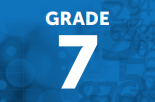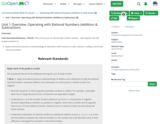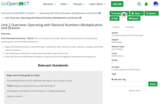
This word problem requires students to use fractions to solve it.
- Subject:
- Mathematics
- Material Type:
- Activity/Lab
- Provider:
- Illustrative Mathematics
- Provider Set:
- Illustrative Mathematics
- Author:
- Illustrative Mathematics
- Date Added:
- 05/01/2012

This word problem requires students to use fractions to solve it.

CSDE Model Curricula Quick Start GuideEquitable and Inclusive Curriculum The CSDE believes in providing a set of conditions where learners are repositioned at the center of curricula planning and design. Curricula, from a culturally responsive perspective, require intentional planning for diversity, equity, and inclusion in the development of units and implementation of lessons. It is critical to develop a learning environment that is relevant to and reflective of students’ social, cultural, and linguistic experiences to effectively connect their culturally and community-based knowledge to the class. Begin by connecting what is known about students’ cognitive and interdisciplinary diversity to the learning of the unit. Opposed to starting instructional planning with gaps in students’ knowledge, plan from an asset-based perspective by starting from students’ strengths. In doing so, curricula’s implementation will be grounded in instruction that engages, motivates, and supports the intellectual capacity of all students.Course Description: In Grade 7, instructional time should focus on four critical areas: (1) developing understanding of and applying proportional relationships; (2) developing understanding of operations with rational numbers and working with expressions and linear equations; (3) solving problems involving scale drawings and informal geometric constructions, and working with two- and three-dimensional shapes to solve problems involving area, surface area, and volume; and (4) drawing inferences about populations based on samples. Upon completion of this course students will have the ability to Analyze proportional relationships and use them to solve real-world and mathematical problems. Apply and extend previous understandings of operations with fractions to add, subtract, multiply, and divide rational numbers. Use properties of operations to generate equivalent expressions. Solve real-life and mathematical problems using numerical and algebraic expressions and equations. Draw, construct and describe geometrical figures and describe the relationships between them. Solve real-life and mathematical problems involving angle measure, area, surface area, and volume. Use random sampling to draw inferences about a population. Draw informal comparative inferences about two populations. Investigate chance processes and develop, use, and evaluate probability models.Aligned Core Resources: It is critical that curriculum be implemented using high quality instructional materials to ensure all students meet Connecticut’s standards. Ensuring alignment of resources to the standards is critical for success. There are tools that are available to districts to assist in evaluating alignment of resources, such as CCSSO’s Mathematics Curriculum Analysis Project and Student Achievement Partner’s Instructional Materials Evaluation Tool. In addition, there exist compilations of completed reviews from a variety of resources. Some of these include but are not limited to EdReports, Louisiana Believes, CURATE, and Oregon Adopted Instructional Materials.Aligned Core Programs: The CSDE in partnership with SERC has engaged with providers of high-quality vetted resources to provide additional alignment guidance to the CSDE model curriculum. High-quality instructional resources are critical for improving student outcomes. The alignment guidance is intended to clarify content and support understanding for clear implementation and coherence. Materials selection is a local control decision and these documents have been provided from participating publishers to assist districts in implementation. Use of the materials from these publishers is not required. These aligned core programs meet expectations as reported by EdReports. If your resource is not listed below, you are encouraged to review EdReports to ensure the alignment of your resource to the Connecticut Core Standards. Strong alignment of curricula and instructional materials have the potential to support student engagement of meaningful grade level content daily and teacher growth. Carnegie Learning Math Grade 7EdGems Math Grade 7enVisions Grade 7Eureka Math Grade 7Fishtank Plus Math Grade 7HMH Into Math Grade 7Imagine Learning Illustrative Mathematics Grade 7i-Ready Math Grade 7MidSchoolMath Grade 7Open Up Resouces Math Grade 7Reveal Math Grade 7Additional Course Information: Major work of Grade 7 mathematics focuses on ratios and proportional relationships and arithmetic of rational numbers. Habits of Mind/SEIH/Transferable Skills Addressed in the Course: The Standards for Mathematical Practice describe the thinking processes, habits of mind, and dispositions that students need to develop a deep, flexible, and enduring understanding of mathematics. They describe student behaviors, ensure an understanding of math, and focus on developing reasoning and building mathematical communication. Therefore, the following should be addressed throughout the course: Make sense of problems & persevere in solving them Reason abstractly & quantitatively Construct viable arguments & critique the reasoning of others Model with mathematics Use appropriate tools strategically Attend to precision Look for & make use of structure Look for & express regularity in repeated reasoning

Unit Overview/Summary - FOCUS: This unit focuses on the Number System domain. Learning this unit will enable students to: Apply and extend previous understandings of operations with fractions to add, subtract, multiply, and divide rational numbers.

Unit Overview/Summary - FOCUS: This unit focuses on Number Systems and Expressions and Equations. Learning this unit will enable students to: Apply and extend previous understandings of operations with fractions to add, subtract, multiply, and divide rational numbers; Use properties of operations to generate equivalent expressions; and Solve real-life and mathematical problems using numerical and algebraic expressions and equations.

Students are introduced to several types of common medical sensor devices, such as ear and forehead thermometers, glucometers and wrist blood pressure monitors; they use the latter to measure their blood pressure and pulse rates. Students also measure their heights and weights in order to calculate their BMIs (body mass index). Then they use the collected data to create and analyze scatterplots of the different variables to determine if any relationships exist between the measured variables. Discussions about the trends observed and possible health concerns conclude the activity.

This task requires students to be able to reason abstractly about fraction multiplication as it would not be realistic for them to solve it using a visual fraction model. Even though the numbers are too messy to draw out an exact picture, this task still provides opportunities for students to reason about their computations to see if they make sense.